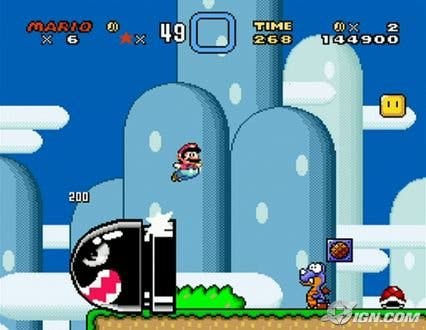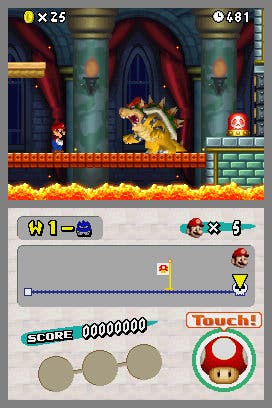The Super Mario Bros. Story
From the archive: a series retrospective.
The Forest of Illusion tuned an already topsy-turvy world on its head by making the secret exit the normal one, and vice versa. The incredible Ghost Houses were dimensional riddles, repeating nightmares for which you had to make up the rules as you went along. Some levels forced the pace, others restricted it, others ripped the ground away completely and hung vast, abstract complexes of moving and crumbling platforms in the sky, where Mario couldn't stand still for a fraction of a second. The gambling mini-games of Toad Houses were replaced with Switch Palaces that altered levels Mario had been to already, or hadn't seen yet. Why satisfy yourself with winning an item when you could change the world?

And why make do with an item when you could have another character? In place of Super Mario Bros. 3's array of suits, the power-ups were stripped back to the old fire flower and the new cape, armed with which Mario could soar across (or on one memorable occasion, under) entire levels in a strangely noble, permanent bellyflop. But they were joined by a power-up with a life of its own: Yoshi.
Mario's dinosaur steed wasn't just a powerful item, with his straining flutter-jump - he was a portable ecosystem, a factory for turning one thing into something else. He could eat enemies and spit them out as weapons, recollecting the mechanics of Doki Doki Panic, but also gain weight, breathe fire, grow wings, turn fruit into mushrooms. In later levels he came in different colours with different abilities and had to be fed up from a hatchling. There was nothing about the game that Yoshi didn't change.
The spirit of Super Mario Bros. was defined in the very first game. Its possibilities were fully explored in Super Mario Bros. 3. But revisit the entire series today - laying rose-tinted specs to one side - and there can be no doubt that Super Mario World is its pinnacle. Where the NES games are bearable to play, Super Mario World is still a pure joy, as confounding, irresistable and free-spirited as it ever was. It's the best platform game ever made.
Star Road
Then, having reached its height in 1990 - five short years after its birth - the Super Mario Bros. series promptly vanished. Mario disappeared at the top of his jump.
On paper, that's not true. For one thing, Super Mario World had a sequel, and not just any sequel but a game almost as great: the gorgeous and hilarious Yoshi's Island, gaming's finest slapstick comedy. You could argue (and you'd have a point) that its DNA is purer than Super Mario Bros. 2's. But you don't play Mario, it doesn't feature question blocks or Koopa Troopas, and in Yoshi's basic state he can do more than just jump. Yoshi's Island is so good it's heart-breaking, but it's not a Mario game.
As for the plumber himself, just one year later Mario appeared in 3D for the first time. Super Mario 64 changed the game so completely it can't be considered in the same genre, never mind the same series. It laid the groundwork for a new era with all the vision and conviction of the first NES game, but the path ahead of Mario was a much slower and rockier one now - and it didn't lead from left to right.
It was over 15 years before Super Mario Bros. came back.
World 3-1
The smartest, but also the saddest thing about the DS' New Super Mario Bros. is that Super Mario World might as well not have happened. It was all too long ago. It would never have been easy to follow that masterpiece; in the early nineties, Nintendo balked at the challenge and went off at a tangent instead. In 2006, a continuation was impossible. What we got instead was a revival.

You can't even call it a greatest hits - without Yoshi or the power of flight, how could you? The new power-ups were mere novelties (with the exception of mini-Mario, a classic in the making). Structurally, the clock was wound back to Super Mario Bros. 3. The map concealed more tricks and secrets, but you still played it like a game rather than discovered it like a world, and some of its rules concerning lives and save points seemed anachronistic and arcane. On the other hand, the introduction of the ground-pound and wall-kick from the 3D games was a stroke of genius. It added tactile flexibility and acrobatic fun to make up for the retreat from sheer freedom.
From some angles, New Super Mario Bros. looked cynical, a little too slick for its own good. From others, it looked like a better game than either version of Super Mario Bros. 2 - maybe even than the first one. But the truth is, none of this matters in the slightest.
The spirit of Super Mario Bros. refuses to be squashed, and every game in the series - including the DS game - surprises and delights in ways that no other 2D platform game has managed to do. In the end, it doesn't matter what you give to Mario, or what you take away. You can't take away his jump.








